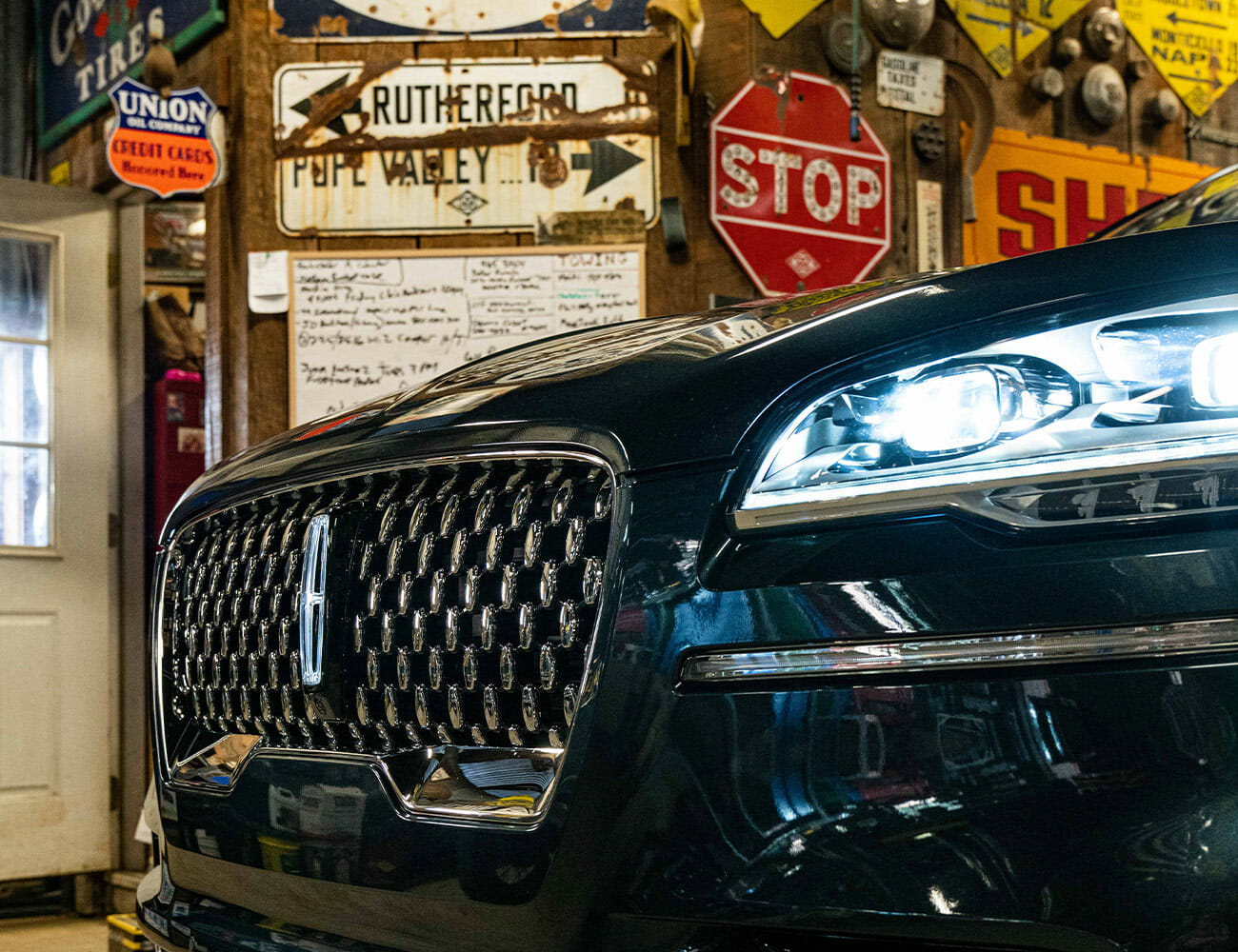The Navigator may be the ne plus ultra flagship of the Lincoln lineup, but the new 2020 Lincoln Aviator is absolutely the fancy FoMOCo SUV to buy. It’s not the hulking monster that the Navigator must be in order to stay competitive with the Escalade, nor does it come with a commensurately steep price tag.
Rather, the Aviator is a sleeker, more stylish, better proportioned and more tech-forward alternative that comes with a hybrid option — one that will blow the doors off the Navigator at a stoplight. With 494 horsepower and 630 lb-ft of torque — numbers that a topped by but a handful of German SUVs — the Aviator Grand Touring Plug-In Hybrid is easily the most fun you can have in a truly luxurious SUV.
The Good: The design is first-rate, with elegant lines inside and out and a slight arc from front to rear that gives it a distinctly sporty vibe. But the real experience of the Aviator is the interior; it’s comfortable yet supportive, roomy and sublimely elegant. The sounds system will sweep you away, and the technology offerings will keep you safe and refreshed on the longest of trips.
Who It’s For: Lincoln has traditionally been something of an awkward fit among the options for American buyers. After all, the snobs will argue, why would you buy this over a Cadillac, BMW, Mercedes, Audi, et cetera? It’s always had an unfortunate retiree/golf-dad vibe to it.
That’s something Lincoln’s brand-rebuilding exercise has attempted to replace with an aura of elegance and sophistication. I hope this effort continues to take, because the Aviator, along with Lincoln’s other recent efforts, absolutely runs with the big dogs of the automotive world. It’s a car for grown-ups, yes, but grown-ups with the ability to thumb their noses at the more-cliché premium driving alternatives.

Watch Out For: The nose. There’s only one design weakness in the Aviator: a slight downward arc from the hood to the grille. Replace that in your imagination with a slightly more aggressive right-angled transition, and it looks stronger and more enduring. Ten years from now, that curved snout will likely be seen as the only element of the design that isn’t timeless.
Of course, that’s about as minor of a gripe as you can get, and many will likely disagree. But the truth is, there’s not a lot to complain about with this car.
Alternatives: From Germany, the BMW X5 and the Audi Q7 are the obvious three-row alternatives; Stateside, it’s really only up against the Cadillac XT6. All are fine vehicles, but none will truly draw a second glance as Lincoln does.
Review: For obvious reasons — great roads, awesome restaurants — the Napa Valley region of California is a popular draw for car companies launching new vehicles. As a result, I’ve been there quite a bit recently, and have seen most of what the region offers. Given that there’s so much exploration going on in the region, I’d assumed, as well, that there weren’t any surprises left. Every square inch of the place has been driven, drunk, Instagrammed, and Facebooked to within an inch of its life.
But there are surprises left. I found two. One is Pope Valley Repair and Towing, a garage that turns precisely 100 years old this year and looks for all the world like a vintage film set, right down to the ancient road signs, WWII-era Willys Jeep undergoing restoration in the back, display of barbed wire on the wall and the cage holding a pair of rattlesnakes. My colleague and I caught sight of it on our drive, and turned around to investigate. We pulled in and chatted up the owner and his buddy — both at work on a 1930s Ford Model A pickup truck and a ’60s-vintage F100. When we asked if we could bring our car into the front of the shop for some pics, they didn’t bat an eye.
Which brings me to the second surprise I found out there: this Lincoln Aviator. The gents in the shop — clearly Ford guys to the bone — spoke of their relief at seeing Lincoln’s newest, best model roll in unannounced, and of their enthusiasm for vehicles made in the U.S. The words weren’t freighted with any hint of anti-globalism, either. They’re just glad Lincoln’s pushing hard to thrive.
The Aviator, as they experienced when they dipped in for an inspection, indeed pushes hard — for both the company and the customer. It’s a beautiful ride, with crisp details, rich colors and a robust roster of features, including a plug-in hybrid version that delivers startling amounts of power: 494 horsepower and 630 pound-feet of torque, compared to the conventional turbocharged V6’s 400 hp and 415 lb-ft. It’s a blast to drive, and offers a preliminary range of about 18 miles of all-electric performance as well.
Branded as the Grand Touring version, the hybrid packs a 13.6-kWh lithium-ion battery that increases power, but, along with the additional hybrid hardware, adds about 800 pounds. You don’t notice it, though. Nor do you notice the overall mass slowing down even the conventional V6 version; it moves just as smoothly and authoritatively, helped along by a silky 10-speed transmission.
The drive experience is virtually unsurpassed in this class, thanks to the firm and seemingly infinitely-adjustable (okay, 30-way adjustable) seats and the premium Revel sound system, which allows you to dial in whether or not you want to feel like you’re sitting on the stage with the artists, or just right in front of them. Good stuff, that—and it makes for a blissfully engaging drive among people who crave quality audio while carving out road trips or daily commutes.
Driver-assistance systems include the optional Co-Pilot360 package that includes evasive steering assist, active rear braking to prevent backing into something and active parking assistance, along with adaptive cruise control and a lane-keeping system. The head-up display is large and detailed — though I had some trouble getting it to focus properly — and the optional Phone as Key system is a logical, long-awaited development for people who are a bit sick of carrying fobs around.
Once we left the garage in Pope Valley, the drive turned into twisty heaven, with an abundance of switchbacks that, for some passengers, could turn into twisty hell if the vehicle’s body roll were to become excessive. That’s my barometer for a vehicle’s handling when in the passenger seat: How queasy I feel under hard driving. The Aviator did well, though I felt hints of nausea percolating as the miles and g-forces stacked up. But I’ve had far worse in vehicles of this size. The Aviator’s standard air suspension performed admirably, fighting the rolling motion as well as could be expected. Besides, powering out of all the turns with the kind of oomph that both powertrains provided more than made up for a bit of boatiness here and there.
Verdict: There’s no question that the Aviator is one of the most aggressively packaged SUVs on the road today. Not only does it come with top-shelf technology, including the startlingly powerful hybrid option, but it also has an aesthetic that handily trumps the competition. It’s a looker on the outside, and a sublimely satisfying habitat on the inside.
2020 Lincoln Aviator: Key Specs
Powertrain: 3.0-liter turbocharged V6 or 3.0-liter turbocharged V6 with electric motor; 10-speed automatic; rear- or all-wheel-drive
Horsepower: 400 (conventional engine); 494 (hybrid)
Torque: 415 (conventional engine); 630 (hybrid)
Maximum Seating Capacity: 7
Base Curb Weight: 4,764– 5,678 pounds
Lincoln hosted us and provided this product for review.

Hot takes and in-depth reviews on noteworthy, relevant and interesting products. Read the Story

